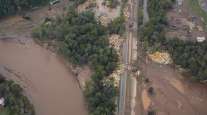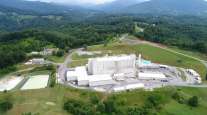Hurricane Harvey Strengthens as Refinery Risk Lifts Gasoline

Hurricane Harvey strengthened as it headed toward landfall in Texas, forecast to become the worst storm to strike the region in more than a decade. The price of gasoline rallied as the storm threatened to wreak havoc on the heart of America’s energy sector.
Harvey became a Category 2 hurricane around midnight in Texas and was packing top winds of 110 miles an hour, the National Hurricane Center said in an advisory posted around 7 a.m. local time Aug. 25. It will be upgraded to a major hurricane once winds reach 111 miles per hour.
Oil refiners in the Gulf Coast, home to as much as half of the nation’s refining capacity, began halting operations amid warnings of deadly floods and storm surges. If Harvey reaches Category 3, it’ll be the strongest storm to hit the U.S. since Wilma in 2005.
“It is becoming pretty clear this morning that Harvey will be mentioned alongside Katrina and Sandy in the history books,” said Todd Crawford, chief meteorologist at The Weather Company.
#Harvey Update: Flooding rains, major hurricane-grade winds, and a storm surge will put Harvey in the history books. https://t.co/gxbQf4LhFk pic.twitter.com/o0MZWc2G8Y — The Weather Company (@weathercompany) August 24, 2017
Harvey has drifted from the southern Gulf of Mexico, regaining strength after passing over Mexico’s Yucatan Peninsula earlier this week. While its course has meant the storm isn’t shutting much oil and natural gas production in the Gulf, it’s set to hit a cluster of refineries that process almost 5 million barrels of oil a day. Harvey was 140 miles southeast of Corpus Christi, according to the advisory. It could come ashore close to midnight Aug. 25, said Crawford.
About 1 million barrels a day of crude and condensate refining capacity in Texas has been shut down by companies including Valero Energy Corp., according to company statements, government releases and people familiar with the situation. About 10% of Gulf of Mexico oil production has also been shuttered.
Harvey may stay closer to the coast, sparing San Antonio and Austin some flooding while inundating Corpus Christi, Houston and the rest of the Texas coast with heavy rains, said Matt Rogers, president of Commodity Weather Group in Bethesda, Maryland. It could bounce back out to sea, reform into a tropical storm or hurricane and have a second landfall near Louisiana by Aug. 29.
Gasoline futures in New York surged to the highest in four months in intraday trade, rising by as much as 4.6% to $1.7406 a gallon, and were at $1.7261 at 7:59 a.m. in New York. Oil pared a fourth weekly loss and traded at $47.81 a barrel in New York.
Harvey may dump as much as 35 inches of rain on areas of Texas over the next week. The Federal Emergency Management Agency is sending staff and supplies to the region. Flooding will probably close roads and inundate plants, while strong winds may disrupt utilities’ systems and knock out power to hundreds of thousands of homes and businesses, leading to a loss of natural gas used to generate electricity and lower prices.
We established an Incident Support Base to pre-position supplies like water, meals, & blankets if requested by the state. #HurricaneHarvey pic.twitter.com/3RWHUDjjwV — FEMA (@fema) August 24, 2017
“We may see major demand destruction on a scale we haven’t seen since Ike in 2008,” Rogers said by telephone.
The Port of Corpus Christi closed for all vessels sailing in or out as part of its hurricane preparations, officials said in an emailed statement. The U.S. Coast Guard shut Houston-Galveston ports to inbound vessels, and energy companies are shutting fuel terminals.
“It is definitely going to be an issue for the ship channels,” said Shunondo Basu, a meteorologist and natural gas analyst at Bloomberg New Energy Finance.
Weather Update: #PortHOU Barbours Cut and Bayport Container Terminals will close today at noon. Truck in-gates will close at 1100. pic.twitter.com/0JI5cI6886 — Port Houston (@Port_Houston) August 25, 2017
Texas Governor Greg Abbott declared a state of disaster for 30 counties and evacuations have begun. A hurricane warning has been issued from Port Mansfield to Sargent, Texas. A storm surge of up to 12 feet may occur near the Padre Island National Seashore to Sargent. Storm surges account for close to half of all hurricane deaths.
Hurricane Ike, a Category 2 storm when it struck near the mouth of the Houston Ship Channel in 2008, killed 103 people across the Caribbean and the U.S., including at least 21 in Texas, Louisiana and Arkansas. It caused about $29.5 billion in damage, according to a 2009 National Hurricane Center report. Property analytics firm CoreLogic estimated Aug. 24 that 232,721 homes along the Texas coast with a reconstruction cost value of about $39.6 billion were at risk of storm surge damage.
Other businesses and markets affected:
• Anadarko Petroleum Corp., Exxon Mobil Corp., Royal Dutch Shell Plc are among the energy explorers that have shut platforms in the Gulf of Mexico; ConocoPhillips and EOG Resources Inc. are among those that have halted drilling in Texas.
• Kinder Morgan Inc. declared force majeure at natural gas compressor stations; DCP Midstream LP shut gas capacity in south-central Texas; and Enbridge Inc. evacuated non-essential workers from some platforms.
• Soybean futures climbed Aug. 24 as crops in Louisiana and Mississippi may be damaged; grain elevators including Corpus Christi Grain Co. suspended shipments; prices were little changed Aug. 25.
• Rain could damage almost 200,000 cotton bales in region, said Chris Yaklin, general manager of Gulf Coast Cooperative.
• BNSF was halting traffic from Galveston Island late Aug. 24 and holding Galveston-bound trains until further notice.
• Policyholder-owned State Farm Mutual Automobile Insurance Co. has the largest share in the market for home coverage in Texas, followed by Allstate Corp., Farmers Insurance and United Services Automobile Association, according to data compiled by A.M. Best Co.
With assistance by Amy Stillman, Sheela Tobben, Naureen S Malik, Barbara J Powell, Mary Schlangenstein, Sonali Basak, Ryan Collins, Laura Blewitt, Jim Polson, Alex Tribou, Alex Longley, David Wethe, Jessica Summers, Jen Skerritt, Catherine Traywick, Sophie Caronello, Tim Loh, and Dan Murtaugh




